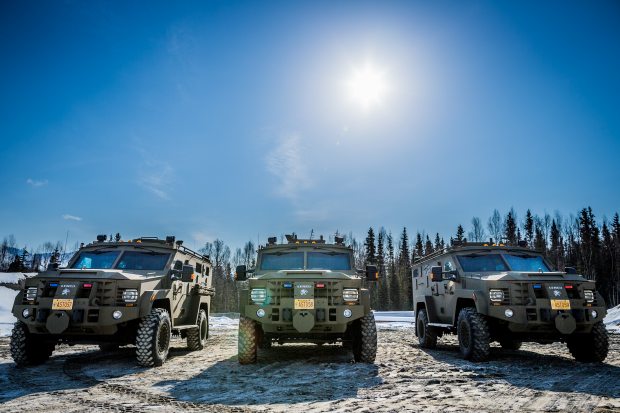Police militarization scrutinized in U.S. — including Alaska

(Loren Holmes / Alaska Dispatch)
Images of armored, rifle-toting officers and tear gas canisters dispersing late-night protestors in Ferguson, Missouri, which followed the shooting death of 18-year-old Michael Brown earlier this month, has prompted President Obama to order a review of outfitting local police departments with gear originally intended for military use.
Some of that gear has been shipped to Alaska over the last decade, from rifles to an armored vehicle the Alaska State Troopers could never get running.
Anchorage police officers or troopers donning full body armor aren’t altogether an uncommon sight. The law enforcement agencies use heavier equipment in volatile situations, including responses to violent suspects who hole themselves up inside buildings. The local and state agencies have been outfitted for such situations in part by federal grants and military surplus.
The U.S. Department of Defense has transferred general and tactical gear to the Alaska Department of Public Safety since 1998, according to data obtained from the Defense Logistics Agency.
The largest cache of firearms was shipped in 2012, when more than 120 5.56 mm rifles landed in the hands of the troopers. Col. James Cockrell said those rifles are “deployed with troopers in the field as one of their patrol weapons.”
Troopers are looking to replace many of those rifles, he said. The agency received a previous batch in 2006. Some of the rifles were Vietnam War-era AR-15s.
Local law enforcement agencies statewide grabbed some of the rifles, as well. Police departments in Fairbanks, Juneau, Ketchikan, Kodiak and the Mat-Su Borough received up to a dozen rifles, according to the data.
Troopers also got seven pairs of night vision goggles back in 1998. The troopers’ Special Emergency Reaction Team used the goggles but has since returned them, Cockrell said.
“They were outdated,” he said.
Armored transports in Alaska
A larger item the troopers haven’t been able to return is a $460,000 armored personnel carrier. The Casspir, which typically offers protection against mines in warzones, sits unused in an Alaska Department of Transportation and Public Facilities lot, Cockrell said.
“We’ve never used it,” he said. “We obtained the Casspir in 2011, and since then it’s been parked in a lot. We’ve been working on giving it back for some time; we never got it running.”
The troopers also own three heavily armored vehicles that work and have been deployed. In March 2013, the troopers unveiled their newly purchased Lenco Bearcat armored personnel carriers.
The 8-ton vehicles carry troopers into high-risk situations, such as combative criminals who threaten to shoot responding law enforcement, trooper and SERT member Randy Hahn previously told Alaska Dispatch News.
“There’s no secret stuff,” said Cockrell. “We don’t have much equipment that I think people are raising concerns about. We are working on upgrading the patrol rifles, which is something we do as money becomes available.”
The troopers paid for the Bearcats themselves rather than inheriting them from any military sources.
Missing from the list of Alaska law enforcement agencies receiving decommissioned military gear is the Anchorage Police Department — the largest local law enforcement entity in the state with 327 sworn and fully-trained officers as of May — though that’s not to say it doesn’t buy directly from the same manufacturers producing equipment for U.S. soldiers.
Anchorage Police Chief Mark Mew said his department was planning to obtain two Mine Resistant Ambush Protected vehicles earlier this year. The Army offered to donate the vehicles but the police department ended up turning them down.
“The department really didn’t think it was going to be worth the maintenance headache, or the cost of having to repaint them,” Mew said.
APD initially reported it would use the vehicles on call-outs of the special weapons and tactics, or SWAT, unit, giving officers something more suitable to hide behind than their patrol vehicles.
Equipment funded by grants
The department does own one heavily armored vehicle. Its SWAT response truck, affectionately nicknamed “The Bear,” was purchased using grant money. Manufacturer Lenco built the response vehicle with a Caterpillar engine, so it can go to a local maintenance shop if it needs repairs.
The vehicle, and its attached ladder system, cost the police department nearly $500,000. All of that money came from a federal grant, said APD resource manager Steve Miko.
Similar grants that paid for police equipment nationwide will be reviewed due to the Ferguson protests. The rush to equip police departments after 9/11 made oversight of the grants difficult, The New York Times reported. One such program the Obama administration likes and the Anchorage Police Department has taken advantage of is the Edward Byrne Memorial Justice Assistance Grant program, which has been used to hire officers and buy weapons and equipment.
In November 2013, the Anchorage Assembly unanimously voted to give the police department $392,943 from that program for a “laptop rehabilitation project.”
A year earlier, the Justice Department’s audit division examined a 2009, $2.7-million grant to APD for computer infrastructure fixes, a foot patrol enhancement project and a methamphetamine education coordinator position, among other uses.
The audit found that “generally … non-personnel expenditures were accurate, reasonable and properly classified.” On the other hand, the department failed to collect and maintain data necessary for measuring grant performance, the audit found.
Questions about training
The call for review from Washington focuses on whether the equipment purchased with grants is being acquired for the right purposes. The larger question is whether there is proper training on how and when to deploy that equipment.
The unrest in Ferguson has been partly attributed to masked, heavily armed police officers trying to keep the peace. Their tactics have come under fire, and retired military officials have criticized police for pointing rifles at people. Retired Gen. Paul D. Eaton told The New York Times soldiers are trained to keep their fingers off triggers.
“The effort is to declare a presence, but not declare you are on the offensive,” he said.
Anchorage police deploy heavy-handed tactics when warranted, Mew said. When the International Whaling Commission met in Anchorage in 2007, the department bought equipment for fear of rowdy protestors, he said. Such protests never occurred. More routinely, military gear often makes an appearance during SWAT call-outs.
“Naturally, SWAT is going to have heavier bulletproof vests that you can’t use in patrol because they’re too big and heavy,” the police chief said. “They have helmets. They have gas masks. We don’t use all those things on every single call.”
According to the latest data available, SWAT teams around the U.S. conducted about 45,000 raids in 2005, up from 3,000 in 1980. And a recent American Civil Liberties Union report found deployments are increasingly being used for routine tasks, such as serving a search warrant.
In Anchorage, a team is typically called out for entrenched and dangerous suspects, Mew said. Alaska Dispatch News requested data from APD on the number of SWAT deployments in Anchorage over the past two years, but had not received it as of Tuesday. Mew, who used to serve on a SWAT unit, estimated the number at generally about one call-out a month. He said deployments haven’t been on the rise.
Still, the police chief said the department has been mindful of discussions about police militarization for several years.
“Ferguson is raising a lot of issues, but there’s been a lot of talk about police departments and their gear for about five years,” Mew said. He said that the department has been “a bit cautious” about rolling out patrol rifles and other military-style equipment.
“We want our officers to have the best tools we can afford to get them, but this isn’t Baghdad.” That’s part of the reason APD hasn’t taken advantage of “hand-me-down equipment” from the military compared to other departments, he said.
Contact Jerzy Shedlock at jerzy@alaskadispatch.com or on Twitter
Related stories from around the North:
Canada: First Nations policing funds renewed for five years in Canada, CBC News
Finland: Police take down wolf prowling residencies in Finland, Yle News
Sweden: Aggressive elk in northern Sweden prompt police warning, Radio Sweden
United States: Panel blasts ‘colonial model’ of justice in rural Alaska, Alaska Dispatch



